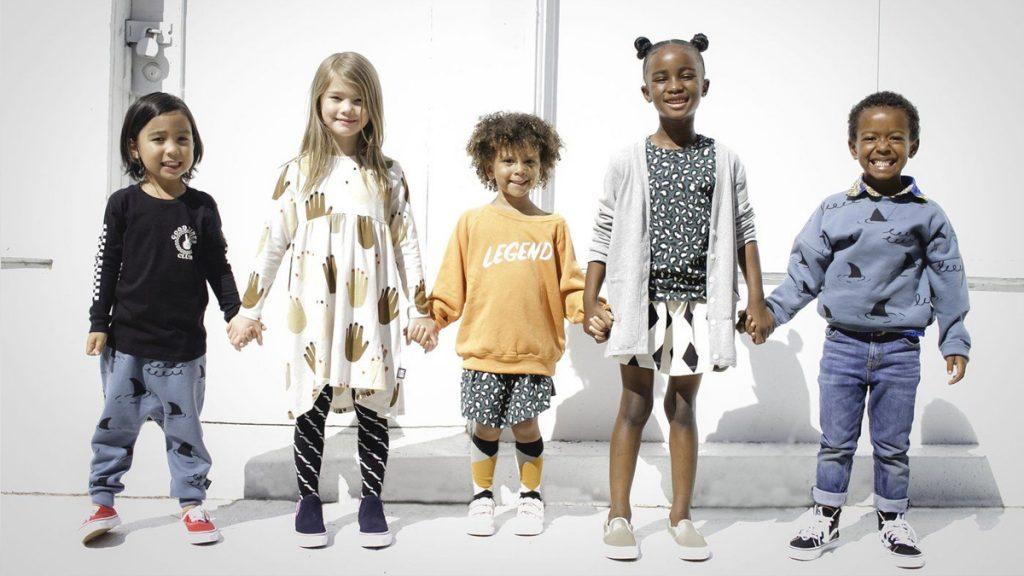Genderless children's clothing: how the trend is becoming a social statement
Breaking all stereotypes, gender-neutral fashion is making its way into children's clothing, and it's here to stay. From FashionUnited we decipher a social change driven by millennials.
What started out as a trend on the runways for men's and women's collections is no longer just a niche statement. Children's fashion is abandoning its old-fashioned cliché of pink and blue, and is opening the doors to unisex garments that allow self-expression and a neutral concept of gender identities.
While John Lewis set the pulse racing in 2017 by removing boys' and girls' labels from his clothing, a host of similar initiatives have since been introduced by other industry players. Old Navy, Carter and Target are among the forerunners, but many new brands have taken off by showing that children's clothing can be stylish without being designed with a boy or girl in mind.
Unisex colors such as grey, beige, black, white or peach are imposed to break with the parameters based on tones. Boys can wear whatever they want thanks to minimal, pattern-free clothing that frees them from societal expectations based on their gender.
Genderless children's clothing focuses on the functional aspect of fashion rather than the decorative, allowing children to play freely in garments that do not restrict movement.
In the last decade, the norms about how to dress as an individual and, therefore, as a child, have been relaxed. Thanks to the genderfluid movement, mainly, stores no longer have to tell customers what is for boys or for girls.

This social change brings many advantages for the little ones: more autonomy, greater self-expression and a more open mind, as well as fewer imposed stereotypes that can affect their development. Instead, it highlights more important values, among which creativity and individuality stand out.
Functional clothing at Monty & Co.
These same notions are reflected in Leigh Montague's collections for unisex children's clothing brand, Monty & Co. The British designer creates functional garments — which are handmade in the UK — that are inspired by workwear and that They represent a sense of purpose.
From overalls and bib overalls to utility jackets, the collections are made from strong natural fibers that allow for extended wear over the years. These pieces are designed with practicality and versatility in mind, two fundamental pillars of unisex children's clothing.
Genderless minimalist clothing is designed with fewer patterns and prints, as well as less bright colors, adding a sense of calm and simplicity for children that flatters their senses. The economic aspect is another advantage, since it allows parents to pass clothes from generation to generation, regardless of the gender of their children.
With retail at the forefront of cultural change, it has become necessary not only to support trends, but to reflect social movements that break stereotypes and raise awareness around genderless clothing.
The rise of millennial parents — and their frustration — is heavily contributing to the rise of genderless children's clothing. This has become especially attractive to them, as parents are prioritizing spending their money on brands that align with their values. As they become parents, this generation's consumers are more likely to shop with brands that focus on inclusivity and encourage change.
The fact that retailers are taking action on this growing demand sends a positive message to a generation that tends to look for brands that share their beliefs. The group behind the Let Clothes Be Clothes campaign is calling on UK retailers to end the use of gender stereotypes in the design and marketing of children's clothing. Many unisex brands, such as Tootsa, JJ Jiraffe, Shapes of Things and Fred and Noah, are committed to positive change for children and are driving the industry down this path.
We must not forget the economic impact of genderless children's clothing. This sector brings novelty without compromising the planet, there are fewer clothes that are thrown away and end up in landfills, and the carbon footprint caused by manufacturing is reduced. Furthermore, it becomes a way for brands and retailers to attract more consumers and increase their profits.
Genderless children's clothing does not have to replace the entire range of children's fashion, but rather represents a social change with a positive global impact. Of course, gender-neutral clothing can be an equal deal to gender-neutral pieces. The ultimate goal is self-expression, and both propositions need to blend together to allow consumers to embrace their true individuality, regardless of their age group.
This article has been previously published on FashionUnited.UK, translated and edited into Spanish by Christin Parcerisa.









Related Articles